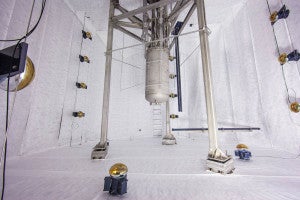The world’s most sensitive dark matter detector, the Large Underground Xenon (LUX) detector, just completed its 20 month search for the “missing mass” of the universe, coming up empty.
At the International Dark Matter Conference (IDM 2016) in Sheffield, UK, the LUX team presented their findings on their observations of the LUX from October 2015 to May 2016. The results can be found on the LUX Collaboration’s website.
Even though the LUX, which is stationed beneath a mile of rock at the Sanford Underground Research Facility, is the most sensitive detector made yet for researching dark matter, it found no evidence of a dark matter particle. The LUX team is confident that if a particle did interact with the xenon, they would have detected it as the sensitivity of the detector is very precise. With these new findings (or lack thereof), scientists will be able to eliminate many potential inaccurate dark matter models and offer guidance to the next generation of dark matter detectors.
“LUX has delivered the world’s best search sensitivity since its first run in 2013,” said professor Rick Gaitskell from Brown University and co-spokesperson for the LUX experiment in a press release. “With this final result from the 2014-2016 run, the scientists of the LUX Collaboration have pushed the sensitivity of the instrument to a final performance level that is 4 times better than originally expected. It would have been marvelous if the improved sensitivity had also delivered a clear dark matter signal. However, what we have observed is consistent with background alone.”
Even though dark matter has not yet been found, scientists are confident it exists as its effects can be seen in the rotation of galaxies and the bending of light as it makes its way through the universe; it is believed to account for more than four-fifths of the total mass in the universe.
The LUX experiment was designed to look at the leading theory type of dark matter particle called a WIMP, Weakly Interacting Massive Particles. It is believed that billions of these particles pass through us, the Earth, and everything on it; WIMPs don’t interact very strongly with normal matter therefore these ghost-like particles pass through with no evidence they were ever there.
The LUX detector consists of a third-of-a-ton of cooled liquid xenon that is surrounded by very powerful sensors designed to detect tiny flashes of light and electrical charges that may be emitted if a WIMP collides with a xenon atom. As cosmic rays and other radiation could interfere with the dark matter signals, the detector was placed beneath a mile of rock and inside a 72,000-gallon water tank.
Many schools from across the country helped with the data analysis as there was nearly half-a-million gigabytes of data. Brown University’s Center for Computation and Visualization (CCV), the advanced computer simulations at Lawrence Berkeley National Laboratory’s (Berkeley Lab), the National Energy Research Scientific Computing Center (NERSC), and the U.S. Department of Energy (DOE) Office of Science User Facility all took a part.
“I am particularly pleased with the support LUX received from NERSC in processing these data,” said Kevin Lesko, the group leader of Berkeley Lab’s Dark Matter group. “The Berkeley students, post-docs and visitors working on this analysis made extensive use of the NERSC for event scanning, calibration, Monte Carlo simulations and the data-blinding scheme.”










